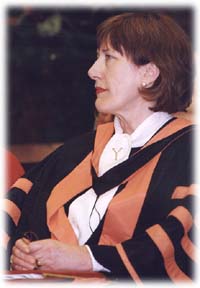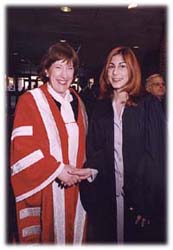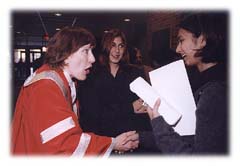 |
|
Pictures at an Installation 
As a rite of passage, the ritual of a presidential installation is filled with costume, procession, music, and speeches. Its purpose is to effect and mark a change in the status, condition and relationship of the president to his or her new university. Maybe it was fitting that as Dr. Lorna Marsden was installed inside Osgoode Hall Law School's Moot Court, outside a rainbow appeared. Surely a good portent for a presidency. October 20, 1997, was also a unique day in Canadian university history, because it marked the first time a university presidency had passed from one woman to another; from president Susan Mann to Marsden.
Something Funny Happened on the Way to the Installation...
Three of York's past presidents tell all Installations are like weddings. There's always something bound to go wrong. And even if all goes right, there's usually a poignant moment to remember. Three of York's past presidents recall fond, and not-so-fond, memories of that life-changing day. "I got to choose the day. So I picked my 50th birthday. "The other thing that I distinctly remember was having a waiter spill a boat of Hollandaise sauce over my suit and gown when I was at the head table. "When I was in the washroom mopping up, someone said, 'If I were you I'd sue the university and get yourself a new suit.' I replied, 'You're right. That's a good idea. The only problem is, I AM the univeristy.'"
President emeritus Harry Arthurs
"I said, 'I guess it's that more of the intrigue takes place in the open.' "
President emeritus Ian Macdonald "I also got to choose my installation day. I picked November 12, my daughter's birthday. That was special to me. "Other than that I remember it was pouring rain, and that I fell down the treacherous stairs of Burton Auditorium! "How did I feel about my installation day? For me it was like going into a new world and making a commitment to do the best you can, while knowing that world would always, somehow, remain quite mysterious. "I remember this: I wore my own Laval gown. In the ceremony you have it taken from you you're not allowed to take it off yourself and it was placed on my chair, and a new gown [York's presidential gown] was put on me. I remember thinking how lonely my old one looked. It seemed sad sitting there." Susan Mann President (1992-1997) Pomp and Circumstance
On the importance of ceremony
The ritual of presidential installations indeed, much of university ceremony is profoundly medieval, says History and "The granting of degrees, the ceremony, the idea of homage, the colour and style of academic robes is profoundly medieval and clerical," says Cohen. "It involves symbolic gestures that just don't stand for something, they are the thing. It's like dubbing a knight you gave him a whump. The concreteness of gesture [for example, handing someone their degree] is both ecclesiastical and lay," he notes. "Even the procession, where we walk two-by-two, is ecclesiastic. "Putting on clothing robes, hoods, hats echoes the Church's influence. When you became a monk, for instance, you donned clothes. In a sense, the President of a university has to be 'neutralized'. She submits to our clothing. She takes the University's colours. She becomes a member of the corporation (like the old medieval guild) by literally having it placed upon her shoulders."
"Even in modern life we have certain times when we revere ceremony. People feel them. There are deep elements within ceremony that are non-Christian. Modern life may push us toward isolation, but at the same time we have an appetite for ritual and its expression. "One thing about many rituals [like an installation] is that if they are not archaic then they are archaizing...they create a sense of a long past, which legitimates. "And, as with joining medieval guild, at the end of ceremonies you sit down and eat. There is the formal presidential dinner. With that the rite of inclusion, incorporation, and passage is complete." Dress CodeRegulations governing York's academic dress were established in 1965 by York's Senate. Participants are normally expected to wear the cap, gown and hood of an academic degree which they hold (usually the highest degree), or the cap and gown which they are entitled to by virtue of their status within the University.
The Robe indicates a status held at York, not a degree, so it is never worn with a hood. The cap worn with the Robe indicates the nature of the status held. A member of Senate wears the round black velvet bonnet of York, with a gold cord, while a Dean would wear a scarlet velvet doctoral bonnet with a gold cord. If you're senior administrative staff you get the Robe, but no fancy hats just a mortar board with tassel. |
|
Text Menu [ Home | Past Issues | Subscriptions | Contact Us | Site Map | Search Profiles ] |
 "At the time, I remember Walter Gordon (who was then Chancellor, and had been a former Minister of Justice) asking me what the difference was between Queen's Park (where I'd worked for the past 10 years) and York?
"At the time, I remember Walter Gordon (who was then Chancellor, and had been a former Minister of Justice) asking me what the difference was between Queen's Park (where I'd worked for the past 10 years) and York?
 It's curious, but perhaps not surprising, that anachronistic ceremonies such as installations even exist today, says Cohen. "I think the anachronism is enjoyed. It's safe because it is far away these aren't multicultural rituals, they're rituals from a European tradition. But they're very old, they are tolerated.
It's curious, but perhaps not surprising, that anachronistic ceremonies such as installations even exist today, says Cohen. "I think the anachronism is enjoyed. It's safe because it is far away these aren't multicultural rituals, they're rituals from a European tradition. But they're very old, they are tolerated.
 The Chancellor's robe is black and gold, as at most universities. Presidents wear the University colours (red and white). Anyone who holds an administrative or teaching appointment may wear the York Robe which is black, with scarlet velvet front facing extending into a scarlet velvet collar.
The Chancellor's robe is black and gold, as at most universities. Presidents wear the University colours (red and white). Anyone who holds an administrative or teaching appointment may wear the York Robe which is black, with scarlet velvet front facing extending into a scarlet velvet collar.